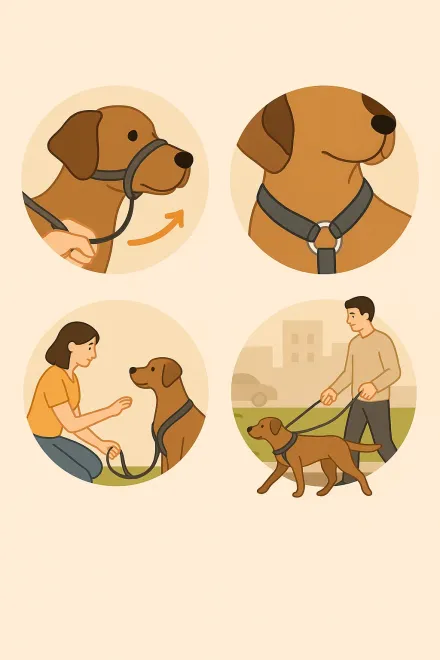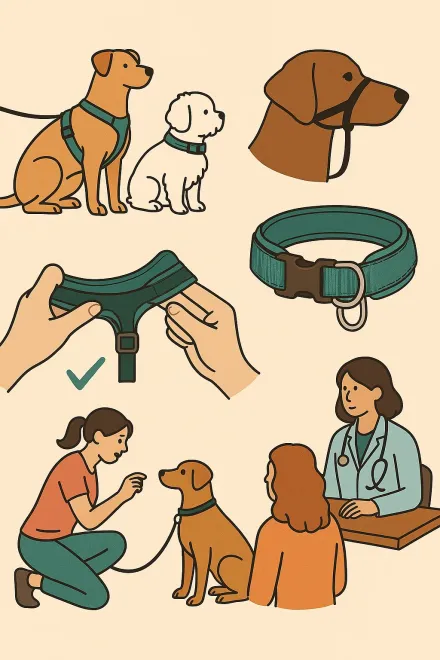No-Pull Dog Collars
No-pull dog collars are designed to help control dogs that pull on the leash during walks, without using aggressive methods. Their main purpose is to reduce pulling gradually by distributing pressure in a controlled way or redirecting the dog’s movement.
This guide explains how these collars work, when they are recommended, the different types available, and which brands are most praised for their effectiveness and respect for canine well-being.
View No-Pull Dog Collars on Amazon
Why Use a No-Pull Collar?
No-pull collars are helpful tools to improve walking behavior, especially in young, energetic, or untrained dogs.
- They reduce pulling progressively: By applying light pressure to specific areas (like the neck, muzzle, or chest), the dog’s urge to pull decreases.
- They prevent neck injuries: Unlike traditional collars, some models distribute pressure to avoid harming the trachea or cervical spine.
- They aid in dog training: Many trainers recommend them to teach proper leash walking behavior.
- They enhance safety: Better control during walks reduces the risk of sudden street crossings or escapes.
These collars should not be seen as punishment, but as temporary support in the process of teaching calm and safe walking.
Types of No-Pull Collars and How They Work
There are several types of no-pull collars, each using a different mechanism to correct pulling:
- Head collars (like Halti or Gentle Leader): Fit over the muzzle and redirect the dog’s head toward you when they pull. Very effective but require an adjustment period.
- Pressure-controlled collars: Slightly tighten when the dog pulls. They don’t choke but apply an unpleasant pressure to discourage the behavior.
- No-pull harnesses: While not collars, they serve the same purpose. They gently turn the dog toward you when they pull, without pressure on the neck.
- Rounded prong collars: Very controversial, only to be used under professional supervision and never as a first option.
Choosing the right type depends on your dog’s size, strength, training level, and preferred approach (mechanical, educational, or both).


Tips for Choosing the Best No-Pull Collar
Before buying a no-pull collar, consider these key factors:
- Dog size and breed: Large or muscular dogs need stronger collars; small breeds require softer, lightweight models.
- Training level: For untrained dogs, a head collar or no-pull harness may be safer and more effective.
- Material: Ensure it’s soft to the touch, breathable, and features reinforced stitching. Internal padding is recommended.
- Fit: It should be snug but comfortable. Too loose won’t correct pulling; too tight may cause discomfort.
- Combine with training: The collar alone won’t solve the issue. Use it alongside positive reinforcement exercises.
Always consult a vet or dog trainer if you’re unsure about the best model for your specific case.
Frequently Asked Questions About No-Pull Dog Collars
Do no-pull collars hurt the dog?
No, as long as they’re used correctly. No-pull collars aren’t designed to punish but to gently correct pulling through mild pressure or redirection. It’s important to fit them properly and not leave them on longer than necessary.
Is a collar or a harness better for no-pull training?
It depends on the dog. Head or pressure collars can be more effective for strong pullers or large dogs. No-pull harnesses are ideal for small, sensitive breeds or dogs with delicate necks. It’s often best to try both and see what works best.
How long should I use it?
A no-pull collar should be used as a temporary tool during the training phase. Over time, with positive reinforcement, your dog should learn to walk calmly and transition to a standard collar or harness.
Can it be used on puppies?
Yes, but with caution. Only use soft models properly fitted to the puppy’s size. Generally, it’s best to start with lightweight no-pull harnesses and combine them with early training.
How do I know if the collar is working?
You’ll notice your dog pulling less or not at all. If there’s no improvement after several walks, check the fit, try a different model, or consult a professional trainer for guidance on how to use it effectively.
Can I use it with a clicker or treats?
Yes, and that’s actually the best approach. A no-pull collar should always be paired with positive reinforcement techniques: clicker, treats, verbal praise, or stopping when your dog walks correctly. This leads to faster and more positive learning.
